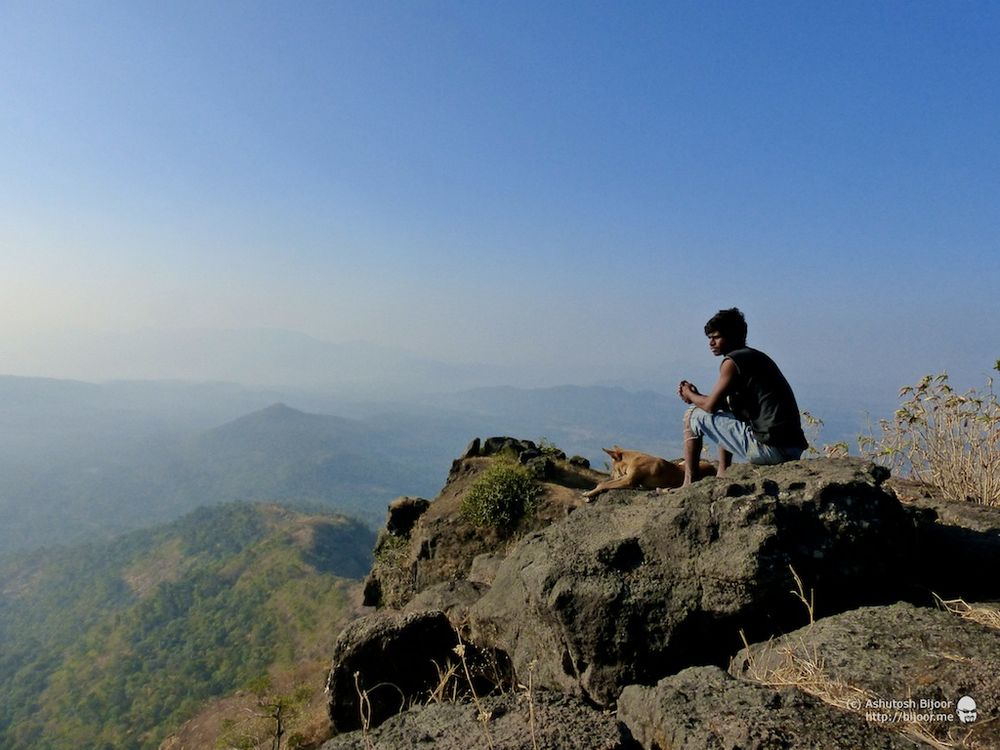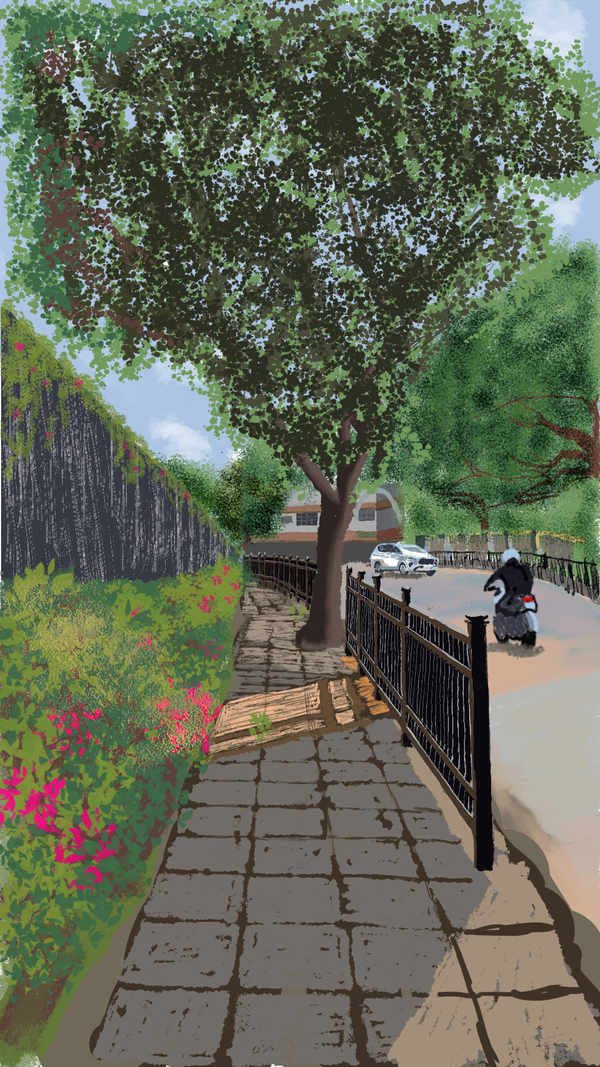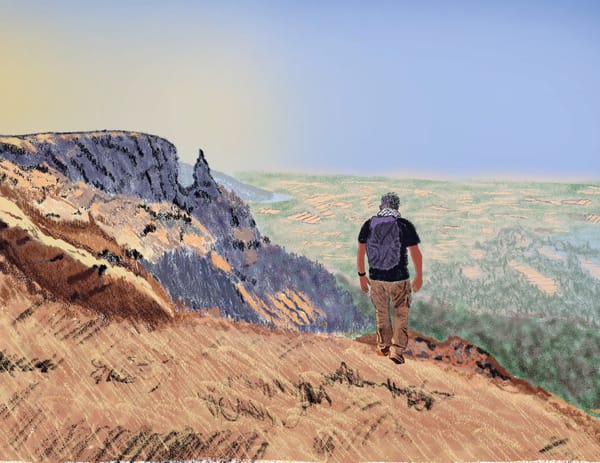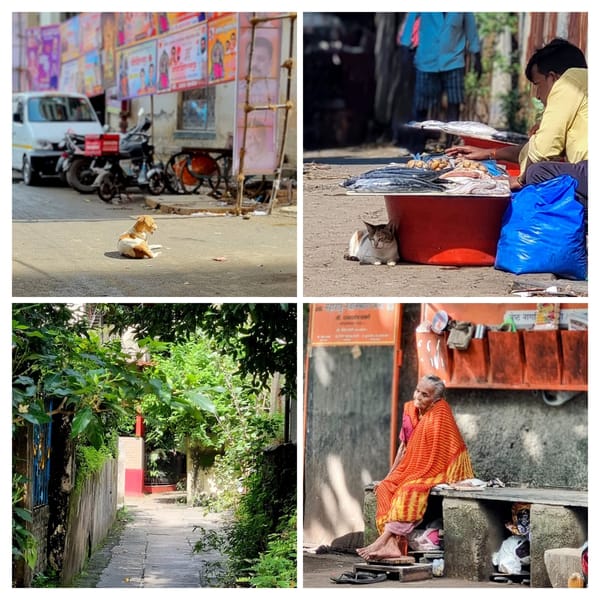Trek to Takmak Fort - a story of the boy and his dog
Of the many forts in the Thane region, all of which were primarily built and managed by the Portuguese during their reign of Bassein (Vasai) in the 16th century. Takmak Fort is on a hill to the north east of Virar, on a hill at a height of 2000 feet and it provides some amazing views of the confluence of the Tansa and Vaitarna rivers to the west of the fort, and of Vandri lake near Vajreshwari to the north-east.
The climb up to the fort starts at a small village called Sakwar, located at a distance of about 20 km from the nearest station – Virar. We drove from Mumbai on the Mumbai Ahmedabad highway (NH8), and took take a right at the exit about 10 km after the Virar exit to arrive at Sakwar at 6 am, when it was still quite dark
 We followed the map to reach Sakwar village and stopped right in front of the gates of the Goshala (cow shelter). It was just past 6 am and it was still quite dark. There was a small house next to the gate belonging to Mangesh Kamdi and he invited us over to share the warmth of the fire he had lit. While we sat around the fire, Mangesh’s kids had just woken up inside his small home and warming themselves in front of the chula (firewood stove) with a pot of water boiling on it
We followed the map to reach Sakwar village and stopped right in front of the gates of the Goshala (cow shelter). It was just past 6 am and it was still quite dark. There was a small house next to the gate belonging to Mangesh Kamdi and he invited us over to share the warmth of the fire he had lit. While we sat around the fire, Mangesh’s kids had just woken up inside his small home and warming themselves in front of the chula (firewood stove) with a pot of water boiling on it
 We asked Mangesh if someone could guide us on the climb up to Takmak fort. He asked his nephew Sandeep to accompany us. Sandeep brought along his dog Tiger, and they both led us through a small path through thick forests – we surely would have lost our way without him!
We asked Mangesh if someone could guide us on the climb up to Takmak fort. He asked his nephew Sandeep to accompany us. Sandeep brought along his dog Tiger, and they both led us through a small path through thick forests – we surely would have lost our way without him!
 In some places, there were arrows marked on rocks to indicate the right way, but these were few and far between so a guide is surely recommended unless you’re in a mood for finding your way through the forest
In some places, there were arrows marked on rocks to indicate the right way, but these were few and far between so a guide is surely recommended unless you’re in a mood for finding your way through the forest
 As we got out of the forest cover, we looked back to get this amazing view of the forests covered in a haze of a winter fog. The weather was great – cold but not overly so – perfect for a moderately difficult trek
As we got out of the forest cover, we looked back to get this amazing view of the forests covered in a haze of a winter fog. The weather was great – cold but not overly so – perfect for a moderately difficult trek
 A short climb up after exiting the forest cover leads you to the lowest point of the ridge of the Takmak range. The fort is at the other end of the range, and one has to walk along the ridge to reach it.
A short climb up after exiting the forest cover leads you to the lowest point of the ridge of the Takmak range. The fort is at the other end of the range, and one has to walk along the ridge to reach it.
 Sandeep led the way and we followed, with Tiger at our heels. Sandeep insisted that we should come back here in the monsoon as the whole place comes alive with a fabulous green and with streams of water flowing everywhere. He says he really loves this place and comes here often with his dog Tiger – they both love this place!
Sandeep led the way and we followed, with Tiger at our heels. Sandeep insisted that we should come back here in the monsoon as the whole place comes alive with a fabulous green and with streams of water flowing everywhere. He says he really loves this place and comes here often with his dog Tiger – they both love this place!
 Tiger was a truly good looking dog. He followed us closely, and allowed Sandeep to lead the way. He had an odd habit of just freezing in the middle of the trail at random places, and we had to find our way around him till he got out of his trance – and then he would happily trot behind us or run ahead to catch up with Sandeep
Tiger was a truly good looking dog. He followed us closely, and allowed Sandeep to lead the way. He had an odd habit of just freezing in the middle of the trail at random places, and we had to find our way around him till he got out of his trance – and then he would happily trot behind us or run ahead to catch up with Sandeep
 As we walked along the ridge, we could see the vast view of the plains below on either side, with the Vaitarna – Tansa confluence to our left towards the sea
As we walked along the ridge, we could see the vast view of the plains below on either side, with the Vaitarna – Tansa confluence to our left towards the sea
 As we reached the end of the ridge, we could see the last steep climb uphill ahead of us that led to the fort. Takmak fort is at a height of 2000 feet. Takmak is a fortified height rather than a fort, as it consists of a hill-top, 400 yards long by about 100 broad, enclosed with built-up work in the only two places from where the hill top is accessible (ref)
As we reached the end of the ridge, we could see the last steep climb uphill ahead of us that led to the fort. Takmak fort is at a height of 2000 feet. Takmak is a fortified height rather than a fort, as it consists of a hill-top, 400 yards long by about 100 broad, enclosed with built-up work in the only two places from where the hill top is accessible (ref)
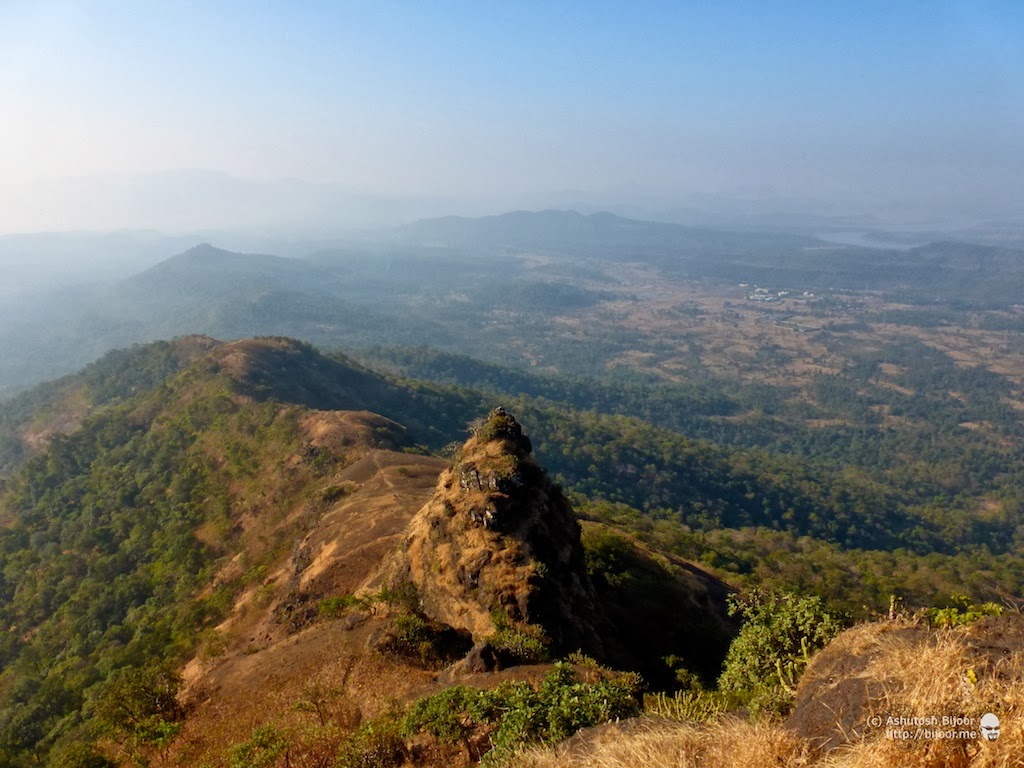 Half-way up the steep climb, there is a small mound like the horn of a rhino and the trail goes around it to climb further up. Behind, in the valley to the right, one can see the Vaitarna river where it confluences with the Tansa river. Dilip decided to wait here for us while we climbed ahead.
Half-way up the steep climb, there is a small mound like the horn of a rhino and the trail goes around it to climb further up. Behind, in the valley to the right, one can see the Vaitarna river where it confluences with the Tansa river. Dilip decided to wait here for us while we climbed ahead.
 When we reached the top of the hill, we came across this built up wall that seemed to be remnants of what was once a much taller structure.
When we reached the top of the hill, we came across this built up wall that seemed to be remnants of what was once a much taller structure.
 Standing on top of the rock at one end of Takmak, I and Tiger are bracing ourselves against the strong wind blowing and looking down at the vast plains around… this is true adventure… feeling at home where you’ve never been before
Standing on top of the rock at one end of Takmak, I and Tiger are bracing ourselves against the strong wind blowing and looking down at the vast plains around… this is true adventure… feeling at home where you’ve never been before
 Looking down one can see the confluence of the Tansa and Vaitarna rivers snaking their way through the plains to the sea. Sandeep tells me that on a clearer day in summer, you can actually see the sea from up here
Looking down one can see the confluence of the Tansa and Vaitarna rivers snaking their way through the plains to the sea. Sandeep tells me that on a clearer day in summer, you can actually see the sea from up here
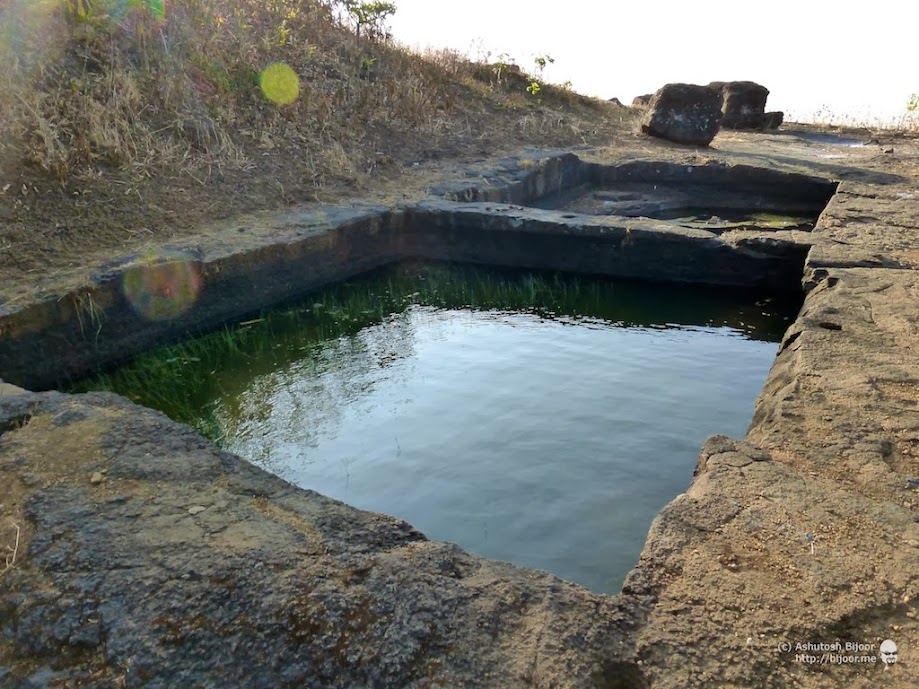 As we walked further towards the other end of the hill top, we came across these water tanks. Though there were algae in the water, Sandeep claimed that this was safe to drink
As we walked further towards the other end of the hill top, we came across these water tanks. Though there were algae in the water, Sandeep claimed that this was safe to drink
 Sandeep quenched his thirst from the tank in this unique style – and I realize that this place truly belongs to him and Tiger – and I feel privileged to be allowed into their world for a brief time
Sandeep quenched his thirst from the tank in this unique style – and I realize that this place truly belongs to him and Tiger – and I feel privileged to be allowed into their world for a brief time
 We walk further and find these two broken cannons in a small clearing. Takmak fort was presumably used first by King Bhimdev (also called King Bimba) in the 11th century, whose capital was Mahikavati (present day Mahim) and who was also credited with the foundation of Mumbai. Later in the 16th century, the Portuguese took over the fort and these cannons likely belonged to them. It was then won over by Maratha warrior Pantaji Moreshwar in 1737 (ref)
We walk further and find these two broken cannons in a small clearing. Takmak fort was presumably used first by King Bhimdev (also called King Bimba) in the 11th century, whose capital was Mahikavati (present day Mahim) and who was also credited with the foundation of Mumbai. Later in the 16th century, the Portuguese took over the fort and these cannons likely belonged to them. It was then won over by Maratha warrior Pantaji Moreshwar in 1737 (ref)
As we reached the topmost and furthermost end of the Takmak fort, we could see the twin peaks of the last hill in the Takmak range with Vandri lake peeping from beyond, and the flat topped hill that is closer in the foreground.
 A zoomed in view of Vandri lake, nestled between the Takmak hills on which we stood and the Kondra hills behind it. The hill in the distance behind could be Kohoj Fort
A zoomed in view of Vandri lake, nestled between the Takmak hills on which we stood and the Kondra hills behind it. The hill in the distance behind could be Kohoj Fort
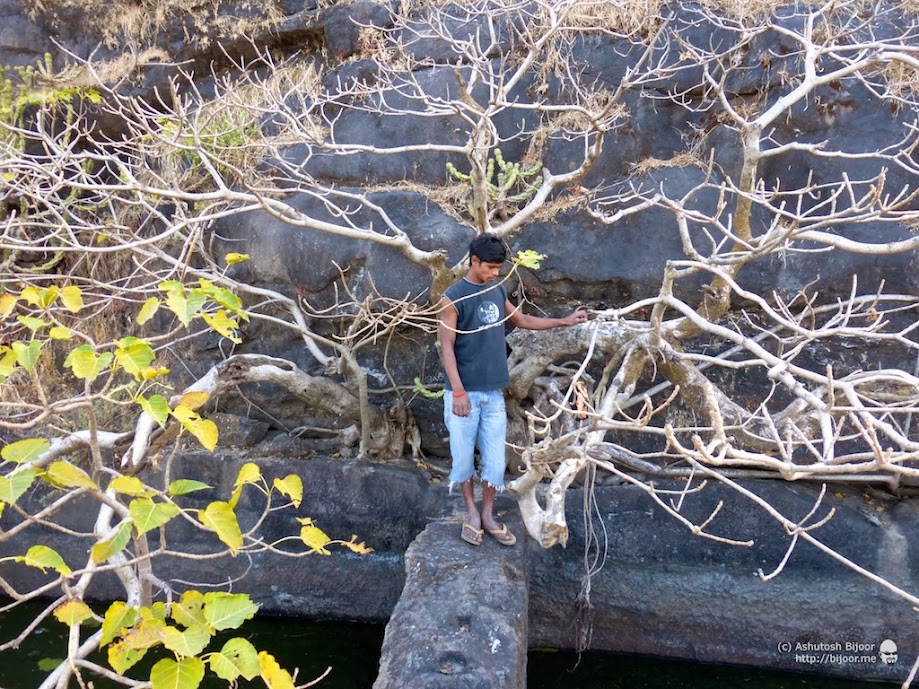 We walked back on the east edge of the hill, and found more water tanks with this shapely tree growing above them. Apparently there are a total of 12 tanks of which 11 are still usable and one is completely buried
We walked back on the east edge of the hill, and found more water tanks with this shapely tree growing above them. Apparently there are a total of 12 tanks of which 11 are still usable and one is completely buried
 We sat around admiring the view of the Vaitarna Tansa confluence in the distance. Tiger’s meditative pose, looking into the distance convinced me that this dog was truly special, just like his friend Sandeep
We sat around admiring the view of the Vaitarna Tansa confluence in the distance. Tiger’s meditative pose, looking into the distance convinced me that this dog was truly special, just like his friend Sandeep
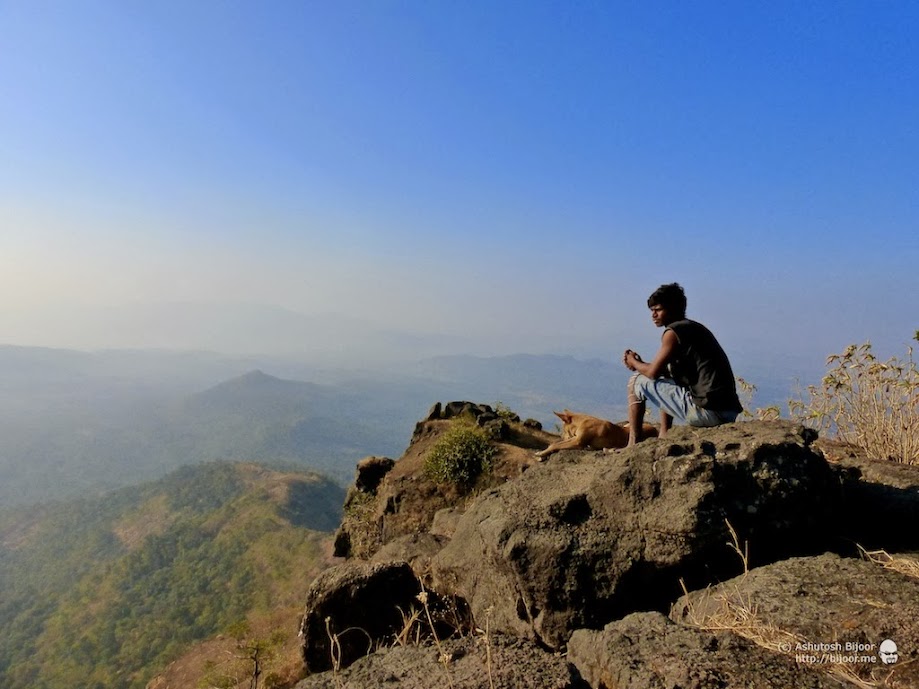 Back where we first climbed up the fort, we again paused to admire the scene. The boy and his dog take their positions on one rock and me on another…. just staring into space
Back where we first climbed up the fort, we again paused to admire the scene. The boy and his dog take their positions on one rock and me on another…. just staring into space
 We then climbed back down the hill and joined Dilip who was waiting for us near the rhino horn hill, and then set out to climb back down the ridge
We then climbed back down the hill and joined Dilip who was waiting for us near the rhino horn hill, and then set out to climb back down the ridge
 A short stretch of a rocky and steep climb down leads us back on to the flat topped ridge
A short stretch of a rocky and steep climb down leads us back on to the flat topped ridge
 Tiger freezes again midway down the climb, forcing us to go around him while he meditates on the rock
Tiger freezes again midway down the climb, forcing us to go around him while he meditates on the rock
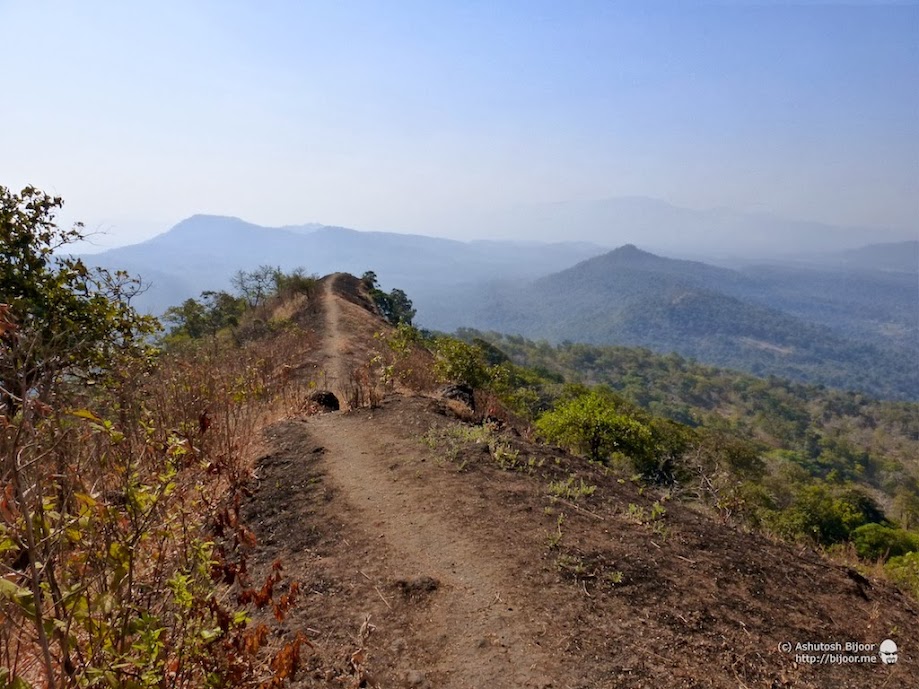 Stairway to heaven, or the closest that you can get to it… the path along the ridge leading to the edge of the Takmak range
Stairway to heaven, or the closest that you can get to it… the path along the ridge leading to the edge of the Takmak range
 Back in the forest on our way down, we note the crocodile bark tree – Terminalia Elliptica. The leaves of this tree are used as food by silkworms which produce the tassar silk (Tussah), a form of commercially important wild silk
Back in the forest on our way down, we note the crocodile bark tree – Terminalia Elliptica. The leaves of this tree are used as food by silkworms which produce the tassar silk (Tussah), a form of commercially important wild silk
 The bark is used medicinally against diarrhoea. Oxalic acid can be extracted from it. Water stored in the stem is often tapped and used as a source of potable water in the summer by forest folk. It is also thought to have curative value for stomach pain (ref)
The bark is used medicinally against diarrhoea. Oxalic acid can be extracted from it. Water stored in the stem is often tapped and used as a source of potable water in the summer by forest folk. It is also thought to have curative value for stomach pain (ref)
 The forest floor provides a rich variety of treasures – this is a variegated shell left behind by a snail
The forest floor provides a rich variety of treasures – this is a variegated shell left behind by a snail
 A skull presumably of a cow eerily looks at you through empty eye sockets
A skull presumably of a cow eerily looks at you through empty eye sockets
 The forests are full of Indian Teak trees (Tectona Grandis) also called as Sag or Sagvan trees with large leaves. A tall, slow growing tree of which timber is highly valued for furniture and in construction (ref)
The forests are full of Indian Teak trees (Tectona Grandis) also called as Sag or Sagvan trees with large leaves. A tall, slow growing tree of which timber is highly valued for furniture and in construction (ref)
 A common sailor butterfly settles on a teak leaf. Thanks to Cleston D’Costa for identifying the butterfly !
A common sailor butterfly settles on a teak leaf. Thanks to Cleston D’Costa for identifying the butterfly !
 Tiger continued to amaze us with his style of quickly dashing around and suddenly freezing in a meditative pose. This is one more of those.
Tiger continued to amaze us with his style of quickly dashing around and suddenly freezing in a meditative pose. This is one more of those.
 By the time we got back out of the forests and walked towards the cow shelter where we had parked, it was close to noon, but the winter air was still quite cool. Behind us, the Takmak range is quite clearly visible, with the rightmost end being the point where we climbed up and the tip towards the left being the highest point in the fort
By the time we got back out of the forests and walked towards the cow shelter where we had parked, it was close to noon, but the winter air was still quite cool. Behind us, the Takmak range is quite clearly visible, with the rightmost end being the point where we climbed up and the tip towards the left being the highest point in the fort
 When we got back, Sandeep insisted on showing us the cow shelter. He led us through the various sheds with cows lined up on either sides
When we got back, Sandeep insisted on showing us the cow shelter. He led us through the various sheds with cows lined up on either sides
 The cow shelter is managed by a trust that also does social work and supports the community in Sakwar
The cow shelter is managed by a trust that also does social work and supports the community in Sakwar
 Sunday is a special time for the kids in Sakwar, for the trust distributes goodies every Sunday morning
Sunday is a special time for the kids in Sakwar, for the trust distributes goodies every Sunday morning
 Parents from the village make it a point to bring their children in their best Sunday clothes and line up outside the gates. The children get sweets and gifts – party time!
Parents from the village make it a point to bring their children in their best Sunday clothes and line up outside the gates. The children get sweets and gifts – party time!
The trek was a great way to spend a Sunday morning with my cousin Dilip who was visiting from the US. But the unexpected bonus was getting to know Sandeep and his dog Tiger. They really made my day!
I hope to visit again in the monsoon – and with the cycle – for the distance from Andheri is just right – about 55 km one way.

